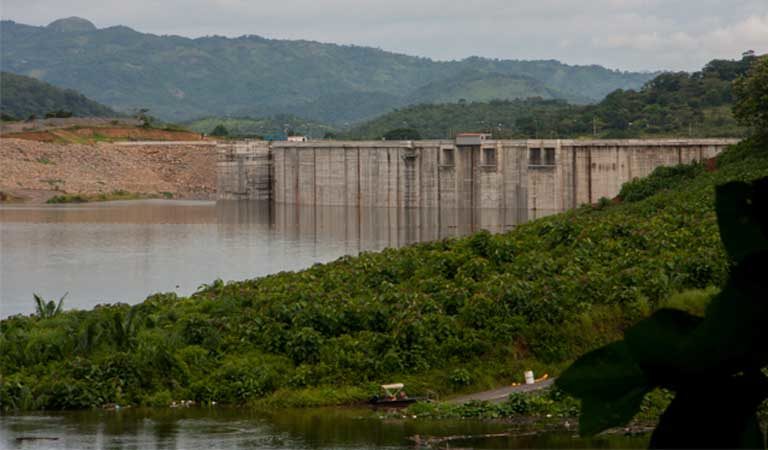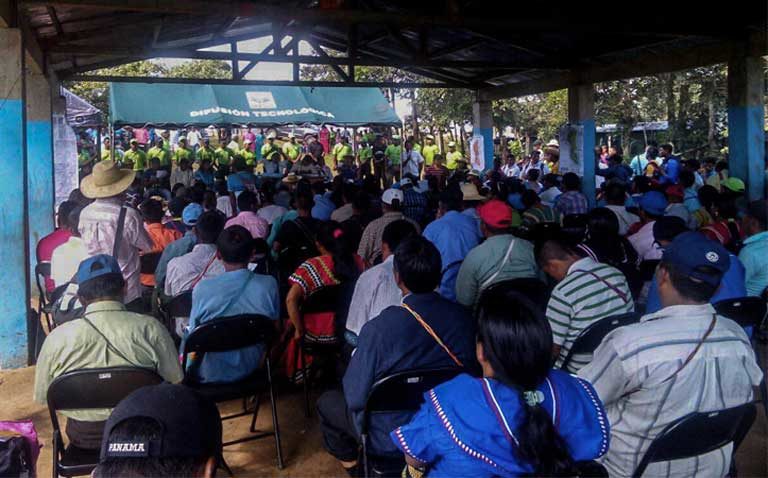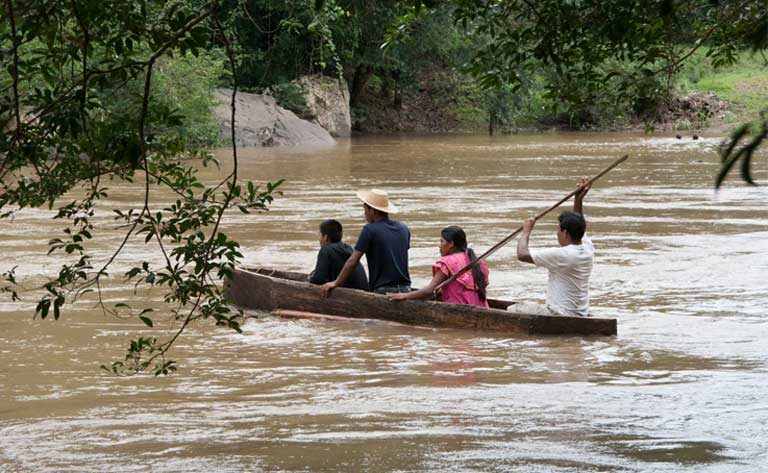Featured image: Ngäbe-Bugle community members canoe on the Tabasará River. By Camilo Mejia Giraldo
by Camilo Mejia Giraldo / Mongabay
- For nearly a decade, Panama’s Barro Blanco dam has met with strong opposition from indigenous Ngäbe communities. It has also generated violent suppression from government forces, and attracted criticism from international organizations.
- An agreement on the dam’s completion, reached by the government and the community’s now-ousted leader, was voted down by the Ngäbe-Bugle General Congress in September 2016. The dam’s surprise deregistration from the UN Clean Development Mechanism in October 2016 did nothing to stop the project.
- Now, the General Administrator of Panama’s National Authority for Public Services has declared that the Ngäbe-Bugle General Congress never presented a formal rejection document to the government, meaning dam operations can begin.
- Panama’s Supreme Court has ruled against the last two legal actions by indigenous communities impacted by Barro Blanco. The Supreme Court decisions cannot be appealed, so the communities have now exhausted all legal avenues within the country, leaving only international processes.
The contentious Barro Blanco hydroelectric dam is set to begin operations within the next few weeks, defying both the relentless opposition by affected communities and the rejection last September by local indigenous authorities of a government proposed project completion agreement.
According to Roberto Meana, General Administrator of Panama’s National Authority for Public Services (ASEP), the 28-megawatt gravity dam in western Panama could begin operation within days once necessary tests are finalized. The reservoir’s waters have been rising since August of last year, gradually flooding Ngäbe communities and land.
“It can be in five days, or it can be two weeks, but the project is very close to entering its commercial operation,” Meana told Mongabay last Friday.
Controversy from the start
The hydroelectric project, partly funded by two European development banks, has been at the epicenter of a complex environmental and human rights battle that has raged on for nearly a decade between a handful of indigenous Ngäbe communities and successive Panamanian administrations.
In the last few months alone, the project was removed from the United Nations’ Clean Development Mechanism (UNCDM), a positive result for the indigenous communities; but has also had two pending legal pleas rejected by Panama’s Supreme Court in favor of the government — potentially opening the door for the forceful expulsion of the affected indigenous people from their lands.
The structurally complete dam on the Tabasará River is set to create a 258-hectare (1 square mile) reservoir within the province of Chiriqui. It will flood 6.7 hectares (16.5 acres) belonging to the Ngäbe-Buglé comarca — a semi-autonomous region located a few miles upstream of the dam.

The Barro Blanco Dam in the Province of Chiriqui, western Panama. The dam is complete and will begin operation within weeks, according to the government. The Ngäbe-Bugle have been opposed to the project since its inception. Photo by Camilo Mejia Giraldo
The imminent operational status of the project now raises serious questions over the future of the local riverside Ngäbe communities, which have continuously called for the dam’s cancellation since it was given the go ahead in 2007.
“If the government is going to start generating [electricity], then they are confirming the violation of our rights as an affected community,” Weny Bagama, a Ngäbe-Bugle General Congress delegate and a leader of the outspoken M10 (Movimiento 10 de Abril) group opposing the dam, told Mongabay.
“They are doing this even though [the Ngäbe-Bugle General] Congress rejected the past agreement,” she said referring to a now defunct accord to allow the dam’s full operation which was reached by the government and the Cacica (negotiators) of the Ngäbe-Bugle community in August 2016. That deal was in turn rejected by the community in September when the Cacica negotiators were ousted by the Ngäbe-Buglé General Congress, the comarca’s key decision-making body.
“The [General] Congress’ decision is the internal decision of the comarca, and if they don’t respect that, then evidently the government just does what it likes and does not respect the jurisdiction established by comarca law,” Bagama said.
According to Meana, however, the Ngäbe-Buglé General Congress’ decision to reject the agreement was not followed by submission of the proper paperwork to the government — a formal document outlining the community’s decision and the reasons for the dam’s rejection.
“To date, there is no document in which this agreement is rejected. The [Ngäbe-Bugle] Congress sent it to be revised. If the Congress had rejected it, they wouldn’t have set up a commission to review it,” Meana said referring to a commission created by the indigenous General Congress to formally analyze the conflict.
These conclusions were strongly opposed by Bagama, who stated that although the congress had not filed a legal rejection document, the congress and the special commission had yet to finalize their response.
“The commission was not named to revise the document but to analyze the conflict in its entirety,” she said. “They didn’t give us a time limit or date to present the [legal rejection] document, but the decision of the Congress needs to be free of pressure or conditions, because the comarca has its own procedures and according to our law we have to follow certain procedures.”

The Ngäbe-Bugle General Congress meets on September 15, 2016 to debate the Barro Blanco agreement. Photo Courtesy of Weny Bagama
The vote by the indigenous body last September appeared to place a cloud of uncertainty over the project, as it was thought by both parties that they would renew negotiations to reach a final agreement.
But even before the indigenous Congress’ rejection, the government allowed the dam’s construction company Generadora del Istmo S.A. (GENISA) to begin test flooding the dam’s reservoir in August, 2016 — a move opposed by the Ngäbe communities that have since lost homes and some of their most fertile land to the rising waters.
“As a community we feel that we are prisoners within our own homes, we can’t move around as we used to, the water levels have dropped slightly [due to the dry season], but all the surrounding land has just turned into mud,” Bagama explained.
“We live in a situation of constant threat because of this reservoir, with what the government has been doing and their economic interests, which are above our livelihoods as indigenous people,” she added.
Partially republished with permission of Mongabay. Read the full article at Panama’s Barro Blanco dam to begin operation, indigenous pleas refused

